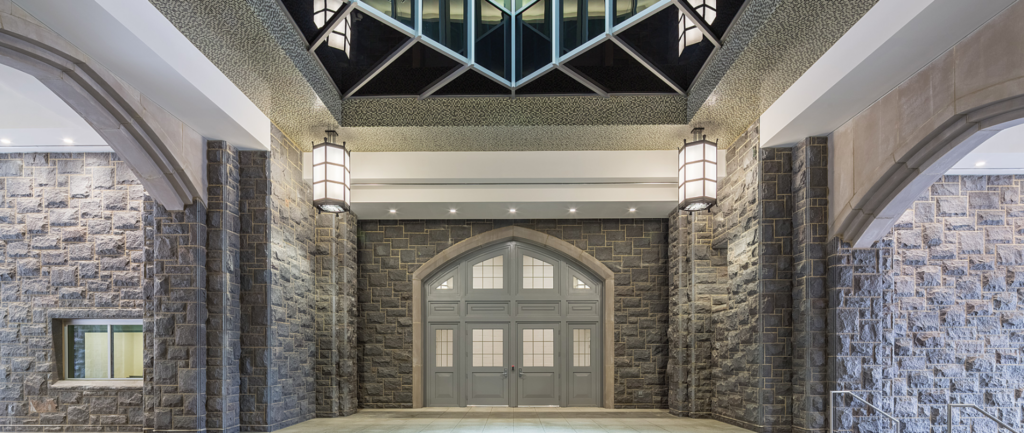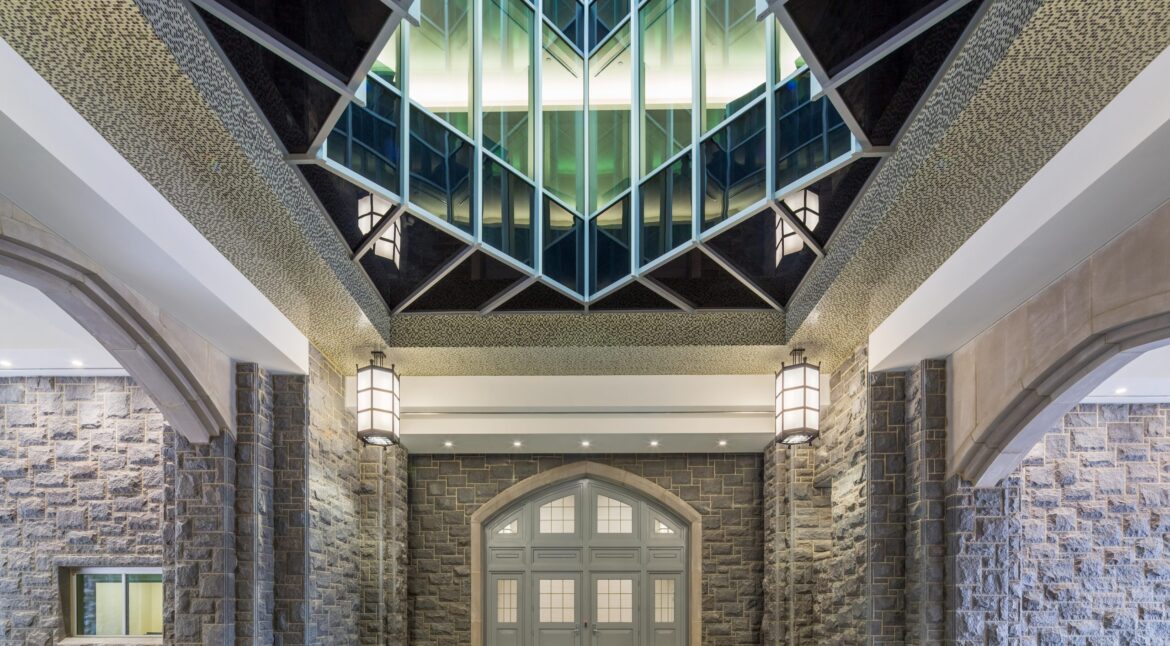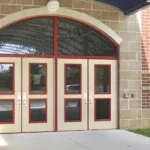
From military installations and government facilities to hospitals and corporate campuses, some locations demand an extra layer of safety against potential gunfire threats. Bullet resistant doors are secure entryways composed of ballistic-resistant core materials and veneered wood or hollow metal products designed to stop bullets. As a result, they are ideal for use in critical facilities such as government buildings, army bases, banks, casinos, emergency, and currency rooms, as they can protect and minimize damage to the people and property inside them.
Healthcare facilities utilize and depend on bullet resistant doors and frames to keep staff and patients safe. According to data from the Gun Violence Archive, which tracks shootings in the United States, there were 739 shootings at healthcare facilities from 2015 to 2021. It’s imperative to keep in mind that even one shooting at a healthcare facility is too many, and that these incidents can have devastating impacts on the individuals involved, their families, and the wider community. It’s essential that steps are taken to mitigate the risk of gun violence and keep people safe in healthcare settings, so they can continue to provide life-saving care to those in need. Bullet resistant doors and frames create an effective barrier between the shooter and the healthcare facilities staff and patients and can provide invaluable time for police and emergency teams to react to the dangerous situation.

Underwriters Laboratories (UL) is an organization that provides safety testing and certification for various products and systems. To establish standardized requirements for creating bullet-resistant components such as doors, barriers, and glass shielding, UL developed a document called UL 752 Standard for Safety for Bullet-resisting Equipment. This document sets criteria for bullet-resistant door and frame assemblies to meet. Ten distinct levels of bullet resistance are established within the UL 752 document and these levels are used to indicate the degree of protection. These levels range from a small .38 mm handgun (Level 1) through to a .50 caliber, high powered, military assault rifle (Level 10).
AMBICO manufactures an extensive range of bullet-resistant steel and wood doors, as well as borrowed and sidelight applications. Our bullet resistant steel and wood doors provide an exceptionally strong protective opening solution. Each door and subsequent component have undergone independent testing to ensure safety and security against ballistic threats. Our bullet resistant steel door and window assemblies protect against ballistic threats from UL 752 levels 1-10, while our bullet resistant wood door assemblies, available with a cross-banded wood face veneer with hardwood edges, protect from UL 752 levels 1-8.

Blast Resistant Door and Frame Assemblies
Blast resistance refers to the ability of a structure or material to endure the pressure produced by an explosion. The term “blast-proof” is not applicable to windows and doors because it implies complete immunity to damage caused by any and all explosions. Instead, the term “blast resistant” is used.
Although it is impossible to prevent explosions altogether, there are methods to minimize, or “mitigate,” damage to the building and its occupants. These techniques include integrating blast resistance into building design, fitting blast-resistant doors and windows, and establishing a distance between the threat and the building, known as standoff, wherever feasible.
Windows and doors that are blast resistant are often designed to flex or “give” when subjected to a bomb blast. However, unlike bullet resistant windows and doors the performance of a blast resistant window and door can be affected by the building structure and how they are installed. After a blast, the extent of permanent deformation to a door impacts its operability, as well as the potential detachment of the door, frame, or their components, including hardware and glass, which can pose a debris hazard. In the case of a glazing system, the level of damage is determined by whether the glazing fractures and if it poses a risk of flying debris. It is crucial to assess and mitigate blast damage to doors and glazing systems to prevent further harm and maintain the safety of occupants and first responders.
Table 1 below shows the ASTM F2927 response categories. This is a commonly specified Standard Test Method for Door Systems subject to air blast loading. The level of damage from a projected blast event on a door assembly ranges from Category I (no damage) to Category IV (catastrophic failure).
Table 1.
| Response | End Rotation | Ductility | Description |
| Category I | 1.2 | 1 | No permanent deformation, and the hardware of the door remains operable |
| Category II | 2 | 3 | Minor permanent deformation, but the door remains operable. |
| Category III | 8 | 10 | Major permanent deformation. However, the door hardware may be inoperable. |
| Category IV | 12 | 20 | Severe permanent deformation and door hardware will be inoperable. |
In category 1, no permanent damage or deformation occurs of the door. Both the door and its hardware remain operable, and the door system has an end rotation that is not greater than 1.2 degrees and a maximum ductility ratio of 1. Category 2 is defined by the end rotation not being greater than 2 degrees and a maximum ductility ratio of 3, which indicates that there will be minor permanent deformation. However, the door will not jam into the frame and all hardware will remain operable. Categories 3 and 4 result in end rotations and ductility ratios that would deform the door permanently and the door would not be operable following a blast event.
The US government has determined that category III blast-resistant doors, also known as the Low level of Protection as defined in the UFC 4-010-01 guidelines, effectively meet the majority of their needs in various governmental and military applications. This decision is based on considerations of cost-effectiveness and practicality. While there may be specific instances requiring higher levels of protection, category 3 door assemblies provide a practical and cost-effective solution to enhance security across their facilities.

In contrast, the petrochemical industry installs blast resistant doors in manned rooms, which makes category II their default option, as they want the doors to remain operable in the event of an explosion. Depending on the application and their requirements, the end rotation and ductility can vary within the allowable range.
Table 2 below shows the Standard Specification Levels for Glazing and Glazing Systems, ASTM F2912. The table indicates performance requirements for glazing or glazing subject to air blast loading. It is used to determine blast capacity from a shock wave or explosion.

AMBICO’s steel blast door assemblies have been designed to provide robust protection against military-grade explosives during high-security events. These doors are constructed with heavy-duty materials that can withstand extreme pressure and shockwaves caused by explosions, and they have been rigorously tested and certified to meet the required industry standards for blast resistance. When installed properly, our blast resistant doors offer a secure barrier against potential threats, such as terrorist attacks or catastrophic failures resulting in explosions. You can have peace of mind knowing that our door assemblies are engineered to provide the required blast protection in the most challenging security situations. AMBICO offers a comprehensive range of doors and frames that are blast-resistant and designed specifically for use in UFC 4-010-01 projects.

In collaboration with the Hazard Mitigation and Disaster Management Research Centre at the University of Ottawa, AMBICO undertook an extensive research and development initiative. The project included subjecting various blast door products of different sizes and configurations to over 55 shock tube tests, in accordance with ASTM F-2927. In addition to this, AMBICO carried out static pressure testing as per ASTM F-2247 and performed finite element analyses. The results of these tests were used to develop software to verify the performance of blast doors and frames under any level of protection, standoff, and charge weight scenario.
AMBICO’s engineering department has the expertise to provide accurate and reliable blast door & frame analysis for almost any charge weight, standoff, level of protection, and door & frame configuration. This empowers them to create doors and frames that are tailored to their clients’ specific needs and to provide reliable protection against intentional explosive threats.
The Inaccuracy of the Commonly Used Word “Bullet Proof”
The biggest difference between the terms “bullet proof” and “bullet-resistant” is that one is often misused, while the other is the real deal. The term “bullet-proof” suggests that a material or object can completely stop any bullet fired at it without any damage. However, there is no material or object that is completely impervious to all types of bullets.
The term “bullet-resistant” is more accurate because it indicates that a material or object can resist or stop the penetration of a specific bullet shot from a specific weapon at a specific velocity and range. Bullet-resistant materials are designed to absorb the energy of a bullet and distribute it across a larger surface area, which helps to prevent the bullet from penetrating through the material.
In addition, the term “bullet-resistant” is more commonly used and recognized in the industry. It is also the term used in official safety standards and certifications, such as UL 752, which defines the requirements for bullet-resistant materials and components.
Therefore, it is important to use the term “bullet-resistant” instead of “bullet-proof” to accurately describe the protective capabilities of materials or objects against bullets.
Similarly, we do not say blast-proof, or explosion-proof, because we know that explosions are powerful forces. If the intensity of the explosion exceeds what the door/window is designed to resist, there is a strong possibility that it could perform to a lower level of protection than it was designed for or fail entirely. However, blast-resistant means the door/window can resist the blast design loads at the specified level of protection. It is the design team’s responsibility with their client to fully define the blast threat and the level of performance (mitigation) requirement.
At AMBICO, we never sacrifice safety. We find it best to plan for what could happen and even go a step further. Click on the links below to know more about our Bullet and Blast Resistant Door and Frame Assemblies:
Bullet Resistant Door and Frame Assemblies
Blast Resistant Door and Frame Assemblies
Contact us today to request a quote or learn more about these strong, resilient, and visually appealing products.



